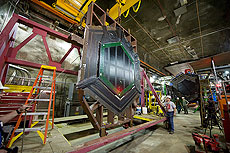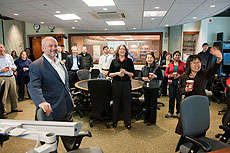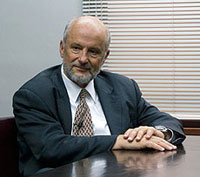|
Have a safe day!
Tuesday, March 16
3:30 p.m.
DIRECTOR'S COFFEE BREAK - 2nd Flr X-Over
4 p.m.
Accelerator Physics and Technology Seminar - One West
Speaker: Steve Holmes, Fermilab
Title: Project X Strategy and Status: A Discussion
Wednesday, March 17
3:30 p.m.
DIRECTOR'S COFFEE BREAK - 2nd Flr X-Over
4 p.m.
Fermilab Colloquium - One West
Speaker: Thomas Levinson, Massachusetts Institute of Technology
Title: The Unknown Detective Career of...Isaac Newton?
Click here for NALCAL,
a weekly calendar with links to additional information.
Upcoming conferences |
|
For information about H1N1, visit Fermilab's flu information site.
|
|
Wednesday, March 17
Lunch
- Orange-herb game hens
- Buttered green beans
- New potatoes
- Key lime pie
Thursday, March 18
Dinner
- Bacon, potato & gruyere souffle
- Medallions of beef with morel sauce
- Parmesan orzo
- Steamed asparagus
- Creme brulee
Chez Leon Menu
Call x3524 to make your reservation. |
|
|
Traffic safety Q&A
As reported in the March 2 issue of Fermilab Today, Fermilab now prohibits the use of cell phones, including hands-free devices, while driving on site. In addition, repeated traffic violations will result in week-long suspensions without pay; non-lab personnel can be banned from site. In response, Fermilab management has received several questions regarding traffic safety, the use of electronic devices while driving and the new Traffic Safety Awareness course that all employees and users must take.
In collaboration with the Traffic Safety Subcommittee, Fermilab management has created a new Web site that lists the answers to the questions received and also provides links to useful resources related to traffic safety on and off site.
Here is a question and answer featured on the new site:
Q. Why has Fermilab adopted a stricter rule than the state of Illinois for cell phone use while driving on the Fermilab site?
A. For most Fermilab employees, the greatest safety hazard is a traffic accident on site. Fermilab is committed to reducing this risk. According to studies cited by the National Safety Council, the use of cell phones, even hands-free devices, is the most significant distraction that affects driving performance.
Learn more |
MINERvA installs final planes
 |
| Technicians from the MINERvA collaboration added the last detector plane to the neutrino experiment on Monday. |
|
Atom and Eve: Fermilab's First International Women's Day
 |
| To kick off Fermilab's first International Women's Day, Deputy Director Young-Kee Kim greets CERN luminaries as Director Pier Oddone and a roomful of Fermilab employees look on. |
Monday, March 8, dawned gloomy and forbidding at Fermi National Accelerator Laboratory. Thick curtains of gray fog obscured Wilson Hall's upper floors, giving the high rise the look of a modern-day retreat for a Tolkien villain. But the bleak atmosphere out of doors didn't extend beyond the building's sturdy walls. At least not inside the ROC, Fermilab's remote operations center for the Large Hadron Collider's CMS experiment, where some two-and-a-half dozen people gathered to kick off the laboratory's first ever celebration of International Women's Day.
Perhaps it was all the free coffee, or the palpable sense that, after weeks of intense planning, this thing was actually (finally!) happening, but the mood was downright convivial—more befitting a Friday evening cocktail hour than an overcast Monday morning.
At around 8:30 a.m., the crowd fanned out around one of the command center's enormous computer screens, and the day's festivities officially began. Via video conference, scientists from CERN sent a warm, trans-Atlantic greeting to their female colleagues, and, after some brief speeches on the importance of diversity, handed the floor over to Fermilab.
Deputy-director Young-Kee Kim highlighted women's contributions to particle physics research over the laboratory's lifetime. She also looked to the future. "I hope this day is not only a celebration, but an inspiration to young women considering a career in science," she said.
Echoing Kim's remarks, Director Pier Odonne wrapped up the video conference and called upon the particle physics community to try to bring more women to the field.
Read more and view a slideshow of images from CERN and Fermilab's International Women's Day celebrations.
-- Andrea Mustain
|
Physics lab in underground mine in northern Minnesota studying neutrinos
From Associated Content,
March 15, 2010
An unexpected discovery in an underground mine in Minnesota If you signed up for a tour of the oldest underground iron ore mine in Minnesota what would you expect to see? Tunnels? Caverns? Bats? Mining carts?
Yes, you would find all of these but what you might be surprised to
find there, a half mile below the surface, is an internationally staffed high energy physics lab. Yet this is what our family discovered when visiting the Soudan Mining underground mine site in Northern Minnesota.
The mine, which originated before the turn of the century and was operational until the mid 1960s, provides guided educational tours of the mine tunnels and caverns but twice a day tours are also provided down to the lowest level of the mine which contains an immense physics laboratory contained within a large cavern of the mine.
The first question that came to our mind was, why was this laboratory constructed a half mile beneath the surface? It certainly wasn't for convenience. Every piece of construction material and equipment had to be transported down to the cavern in an elevator and assembled below. It wasn't for security purposes either.
The tour includes a full explanation of the experiments that are being conducted there. The reason for the location is that these experiments need to be done under the earth , because of the need to filter out cosmic rays. Though there are three different experiments that the lab participates in, the one we were fascinated with was the MINOS experiment. MINOS stands for Main Injector Neutrino Oscillation Search. The experiment's purpose is to measure the mass of particles called neutrinos, which are smaller than the nuclei of atoms. So why did they need a huge cavern to study particles smaller than an atom's nuclei? That is evident immediately as you enter the lab. What you see hanging in the center of this immense underground cavern is a huge slab of metal that weighs 5.4 kilotons (that's A LOT, by the way). This large central item of the lab is called a 'detector' and was explained to us to be a sort of very dense 'catcher's mitt' made of magnetized metal and plastic reflectors. This dense object is built for the purpose of 'catching' some of these tiny neutrinos that are actually being shot through the earth from another location.
Read more
|
|
|
HEPAP
 |
| Fermilab Director Pier Oddone |
The High Energy Physics Advisory Panel held its regular meeting in Washington, D.C. during Thursday and Friday of last week It was an important meeting with presentations by the Department of Energy and National Science Foundation on the President's Budget Request for FY2011, a report by Steve Myers of CERN on the turn-on of LHC, a report by Sergei Nagaitsev on the design evolution of Project X, and important presentations and discussions with Ed Seidel, interim director of the Mathematics and Physical Sciences Division of NSF, Bill Brinkman, director of the DOE Office of Science, and Undersecretary for Science Steven Koonin.
The news is very good for science, with substantial increases for both the Office of Science and for NSF. There are particular circumstances that make FY2011 particularly difficult for particle physics.
Ed Seidel explained that NSF recognizes and is working to obtain additional funding for DUSEL beyond the budget request to maintain the design team at Berkeley and the laboratory operations in South Dakota during FY2011 while NSF makes the necessary decisions to launch full construction of the project.
Bill Brinkman explained that top priority within the Office of Science is given to programs that couple to energy and climate change. The President's Budget Request contains an increase in funding for the DOE High Energy Physics Program of 2.3 percent ($18.5 million) above the FY2010 enacted funding level, for a total of $829 million. Under this budget, the portion allocated to Fermilab is $409 million, an increase of $11 million over FY2010. This amount must cover full operation of the Tevatron, including significant power cost increases. It must also cover the operation of neutrino and test beams, ongoing construction of NOvA, support for current research and collaborative activities, and the design of new projects including the Long Base Line Neutrino Experiment (LBNE) and the Muon-to-Electron Conversion Experiment (Mu2e) needed in the post-Tevatron era. By limiting the effort in these future projects and slowing them down as assumed in the FY 2011 budget request, we can accomplish the proposed program. This will require extraordinary efforts under extremely tight funding conditions.
Steve Koonin laid out the priorities of the DOE as: 1) jobs and competitiveness, 2) the transformation of energy technology in the country, 3) national security, and 4) discovery science. He also explained the need to articulate what discovery science brings to 1) 2) and 3). Our field has a remarkable record of historical contributions to medicine, to industrial and security applications, to communications and computing, and to the creation of tools like light sources and neutron sources used for material sciences, chemistry and biology. The challenge for us is to articulate how we will continue to contribute to these areas as we develop the technology for our science at the energy, intensity and cosmic frontiers. Of course we must also articulate the intrinsic value of having a place at the frontier of scientific discovery, beyond the spin-off applications.
|
Progress, but long way to go for women in science
From Beacon News, March 15, 2010
More American high school and college women are majoring in sciences than ever before.
But businesses and government agencies must do more to keep women in science classes and get them into the workforce, sociologist Sandra Hanson said during a Women's History Month lecture at Fermi National Accelerator Laboratory.
"We are definitely making progress, but women remain under-represented in science and science education," Hanson declared. "Women earned 20 percent of the Ph.D. degrees in engineering (in 2006), but they represented only 12 percent of employed engineers."
Read more
|
|
March 12-15
- Four stores provided 49.75 hours of luminosity
- TeV antiproton tune studies
- Booster CAMAC crate 10 problems
- Kautz Road substation breaker trip - Store 7670 aborted
- TeV sequencer and CAMAC crate power supply problems
*The integrated luminosity for the period from 3/8/10 to 3/15/10 was 60.41 inverse picobarns. NuMI reported receiving 7.23E18 protons on target during this same period.
Read the Current Accelerator Update
Read the Early Bird Report
View the Tevatron Luminosity Charts |
|